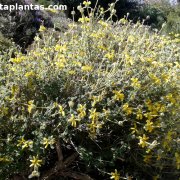Care of the shrub Phlomis lanata or Woolly Jerusalem sage |
|
The genus Phlomis, family Lamiaceae, comprises 100 species of shrubs and herbaceous plants native to Asia and the Mediterranean region. Some species are: Phlomis lanata, Phlomis fruticosa, Phlomis cypria, Phlomis chrysophylla, Phlomis purpurea, Phlomis italica, Phlomis russeliana, Phlomis lycia, Phlomis samia, Phlomis lychnitis, Phlomis maroccana, Phlomis viscosa. Common names: Woolly Jerusalem sage, Small Jerusalem Sage. This species is native to the island of Crete, eastern Mediterranean. They are fast-growing, compact shrubs with hairy stems and leaves that reach 60 cm (23.6") in height. The hairy leaves are opposite, rounded or elliptical, dark green on the upper surface and light grayish green on the underside. The attractive yellow flowers contrast with the foliage and bloom in spring. Woolly Jerusalem sage is used in Mediterranean coastal gardens, in rockery, on dry slopes, in bushy groups, on borders and as isolated specimens. Phlomis lanata needs direct sun exposure and a hot, dry climate. It resists occasional frosts. Small Jerusalem Sage prefers limestone soils, well drained and poor in organic matter. Planting is done in late winter or early spring. Phlomis lanata has very high resistance to drought; water sporadically in summer. The rest of the year it can be maintained with the rains. Woolly Jerusalem sage does not need fertilizers. Prune after flowering to keep it compact. Phlomis lanata is a shrub resistant to the usual pests and diseases. Small Jerusalem Sage is propagated from seeds sown in spring. |
Images of the shrub Phlomis lanata or Woolly Jerusalem sage |
Find plants
Phlomis lanata or Woolly Jerusalem sage | Care and Growing
© 2025 FavThemes




